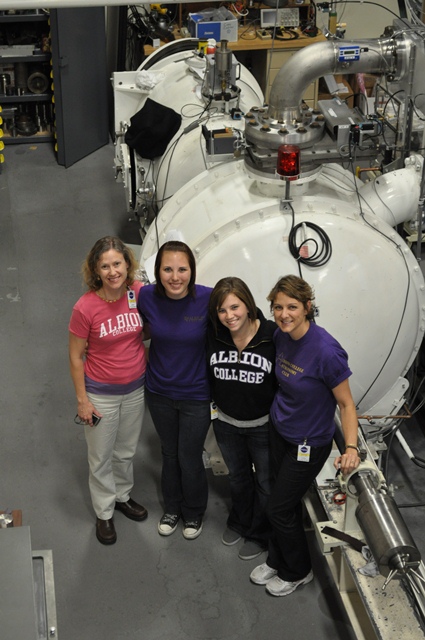2011 Annual Science Report
 Rensselaer Polytechnic Institute
Reporting | SEP 2010 – AUG 2011
Rensselaer Polytechnic Institute
Reporting | SEP 2010 – AUG 2011
Project 8: Survival of Sugars in Ice/Mineral Mixtures on High Velocity Impact
Project Summary
Understanding the delivery and preservation of organic molecules in meteoritic material is important to understanding the origin of life on Earth. Though we know that organic molecules are abundant in meteorites, comets, and interplanetary dust particles, few studies have examined how impact processes affect their chemistry and survivability under extreme temperatures and pressures. We are investigating how impact events may change the structure of simple sugars, both alone and when combined with ice mixtures. The experiments will allow us to understand how sugar chemistry is affected by high pressure events and to contrast the survival probabilities of sugars in meteorite and comet impacts. This will lead to a better understanding of how organic molecules are affected during their delivery to Earth. This project leverages expertise in two different NAI nodes, increasing the collaborative interaction among the NAI investigators
Project Progress
In February 2011, Vanessa McCaffrey and Nicolle Zellner traveled to the NASA Ames Vertical Gun Range to conduct the first set of experiments investigating the effect of shock impact on sugar chemistry. We conducted six experiments with neat samples of glycolaldehyde (GLA) and dihydroxyacetone (DHA), as well as a sample that was a mixture of the two, using target assemblies manufactured by Albion Tool and Dye Company. Sample masses ranged from ~30 mg to ~50 mg. Spherical projectiles were fired from the vertical into the target, at velocities of ~5.5 km/sec and resulting in pressures less than 5 GPa. Upon inspection, there was some color change, but most of the sugar samples stayed powdery and white. Analyses by GCMS, however, showed that chemical changes had occurred, especially in the ejecta samples of both GLA and DHA, but it is not yet clear what products were created.
In early August 2011, McCaffrey, Zellner, and two students (Figure 1) followed up these initial findings with a set of experiments using the flat-plate accelerator at the Experimental Impact Laboratory at NASA’s Johnson Space Center. We tested neat samples of GLA and DHA, as well as a sample of GLA plus a montmorillonite clay that is a known catalyst. Projectiles with and without attached flyer plates were fired from the horizontal onto the target with velocities of ~1.2 km/sec and pressures ranging from ~5 GPa to ~25 GPa, depending on the material of the flyer plate. Sugars changed in color from white to brown and black, and in at least three of the experiments, the samples changed from a powder to a liquid. Ongoing analyses of these reaction products, including GCMS, IR, and CHN microanalysis, are occurring this semester. Additional tests will compare the NASA Ames experiment results with the NASA JSC experiment results.

In front of the flat-plate accelerator at Johnson Space Center. L to R: Vanessa McCaffrey, Erica Bennett, Casey Waun, and Nicolle Zellner
Two undergraduate female chemistry majors have been working with McCaffrey and Zellner. Both worked on the project for 10 weeks in Summer 2010, and both traveled to NASA JSC.
Conference presentations of this work occurred at the LPSC (March 2011), the ISSOL/BioAstronomy meeting (July 2011), and the Australian Space Science Conference (September 2011). Initial results of the Ames experiments are being written up for publication in the proceedings of the conference in Australia.
Publications
- McCaffrey, V.P., Zellner, N.E.B., Bennett, E. & Waun, C. (2011). Assessing the Survival of Simple Sugars After High Velocity Impact. 11th Australian Space Science Conference. Canberra, ACT, Australia.
- Zellner, N.E.B., McCaffrey, V.P., Bennett, E. & Gudipati, M. (2011). Chemistry and Astrochemistry of Simple Sugars: Implications for Asteroid, Meteorite, or Comet Delivery,. Origins 2011 International Conference. Montpellier, France.
- Zellner, N.E.B., McCaffrey, V.P., Bennett, E. & Gudipati, M. (2011). Chemistry and Astrochemistry of Simple Sugars: Implications for Asteroid, Meteorite, or Comet Delivery. 42nd Lunar and Planetary Science Conference.
-
PROJECT INVESTIGATORS:
-
PROJECT MEMBERS:
Murthy Gudipati
Co-Investigator
Vanessa McCaffrey
Co-Investigator
-
RELATED OBJECTIVES:
Objective 1.1
Formation and evolution of habitable planets.
Objective 3.1
Sources of prebiotic materials and catalysts
Objective 4.1
Earth's early biosphere.
Objective 4.3
Effects of extraterrestrial events upon the biosphere
